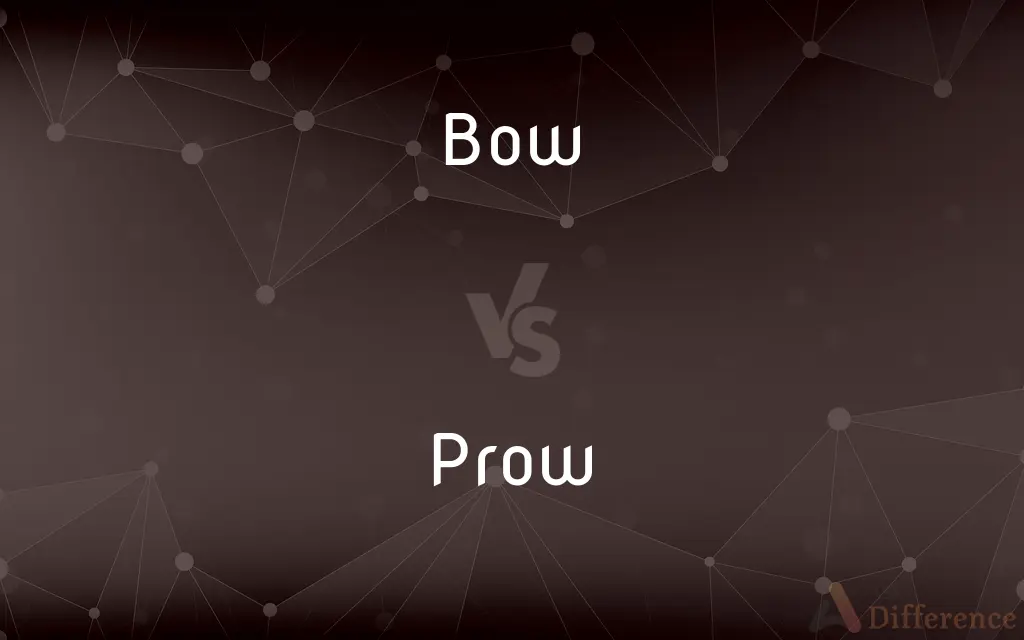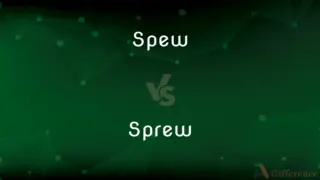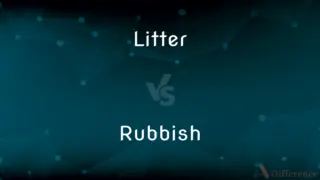Bow vs. Prow — What's the Difference?
By Urooj Arif & Fiza Rafique — Updated on March 28, 2024
A bow is the forward part of a ship or boat, while the prow is the very front end or tip, often distinguished by its shape or figurehead.

Difference Between Bow and Prow
Table of Contents
ADVERTISEMENT
Key Differences
The bow refers to the entire forward section of a ship or boat, encompassing more than just the extreme front. It plays a crucial role in determining how the vessel cuts through water, affecting its speed and stability. On the other hand, the prow specifically denotes the pointed front part of the bow and is often emblematic, featuring distinctive designs or figureheads, especially in historical or military ships.
While the bow's design is critical for minimizing resistance and maximizing maneuverability, the prow often serves as an aesthetic or symbolic element. For instance, Viking ships famously had elaborately carved prows that represented mythical creatures. This contrast highlights the functional importance of the bow in navigation and the prow's role in ship aesthetics and symbolism.
In modern nautical design, the distinction between bow and prow has become less pronounced in terms of functionality. The prow is essentially the foremost part of the bow, but the entire bow's shape and structure are engineered for hydrodynamic efficiency. In contrast, historical vessels placed a greater emphasis on the prow for both functional navigation and as a status or intimidation tool.
Technological advancements have led to the development of various bow shapes, such as the bulbous bow and the clipper bow, each designed to improve performance under specific conditions. These designs focus on reducing drag, enhancing fuel efficiency, and improving stability. The prow, while still the foremost point of the bow, often integrates seamlessly into these designs without a distinct functional purpose beyond its contribution to the overall shape of the bow.
The terms "bow" and "prow" are sometimes used interchangeably in casual conversation, but their differentiation is important in understanding naval architecture and maritime history. The bow's role in ship dynamics and the prow's contribution to a vessel's identity and aesthetic appeal underline the complexity of ship design and cultural significance.
ADVERTISEMENT
Comparison Chart
Definition
The forward part of a ship or boat.
The very front end or tip of the bow.
Function
Affects the vessel's speed, stability, and maneuverability.
Often decorative, can feature a figurehead or distinct design.
Design Focus
Hydrodynamics and performance.
Aesthetics and symbolism.
Significance
Critical for navigation and efficiency.
Represents ship identity and cultural or historical significance.
Examples
Bulbous bow, clipper bow.
Viking ships' dragon heads, Roman ships' rostra.
Compare with Definitions
Bow
Engineered for hydrodynamic efficiency.
The ship's bow was designed to minimize water resistance.
Prow
Reflects ship identity and heritage.
The prow design was unique to the fleet, indicating its cultural background.
Bow
Includes bulbous and clipper bows.
The vessel featured a bulbous bow, reducing drag at high speeds.
Prow
Focused on aesthetics and tradition.
Historical ships boasted elaborately designed prows with intricate details.
Bow
Affects speed, stability, and fuel efficiency.
Innovations in bow design have significantly enhanced fuel efficiency.
Prow
Often carries symbolic or aesthetic significance.
The prow's figurehead depicted a mythical sea creature, symbolizing strength.
Bow
Determines a vessel's handling in water.
A well-designed bow improves the ship's speed and stability.
Prow
The very front part of a ship's bow.
The ship's prow was adorned with a carved wooden figurehead.
Bow
A knot tied with two loops and two loose ends, used especially for tying shoelaces and decorative ribbons
A girl with long hair tied back in a bow
Prow
Featured in Viking and Roman ships.
Viking ships were renowned for their dragon-headed prows.
Bow
A weapon for shooting arrows, typically made of a curved piece of wood joined at both ends by a taut string.
Prow
(Nautical) The forward part of a ship's hull; the bow.
Bow
A long, partially curved rod with horsehair stretched along its length, used for playing the violin and other stringed instruments.
Prow
A projecting forward part, such as the front end of a ski.
Bow
A curved stroke forming part of a letter (e.g. b, p).
Prow
(nautical) The front part of a vessel
Bow
A metal ring forming the handle of a key or pair of scissors.
Prow
A vessel
Bow
An act of bending the head or upper body as a sign of respect or greeting
The man gave a little bow
Prow
(archaic) Brave, valiant, gallant.
Bow
The front end of a ship
Water sprayed high over her bows
Prow
The fore part of a vessel; the bow; the stem; hence, the vessel itself.
The floating vessel swumUplifted, and secure with beaked prowrode tilting o'er the waves.
Bow
Play (a stringed instrument or music) using a bow
The techniques by which the pieces were bowed
Prow
See Proa.
Bow
Bend the head or upper part of the body as a sign of respect, greeting, or shame
He turned and bowed to his father
She knelt and bowed her head
Councillors stood with heads bowed
Prow
Benefit; profit; good; advantage.
That shall be for your hele and for your prow.
Bow
Bend with age or under pressure
The creepers were bowed down with flowers
The roof trusses bowed as the wind fought to rip the roof free
Prow
Valiant; brave; gallant; courageous.
The prowest knight that ever field did fight.
Bow
(of a new film or product) be premiered or launched
The trailer bowed in theaters nationwide on December 23
The Pentium III bowed in early 1999
Prow
Front part of a vessel or aircraft;
He pointed the bow of the boat toward the finish line
Bow
The front section of a ship or boat.
Bow
Either of the sides of this front section
The starboard bow.
Bow
The oar or the person wielding the oar closest to the bow in a racing shell.
Bow
An inclination of the head or body, as in greeting, consent, courtesy, acknowledgment, submission, or veneration.
Bow
A bent, curved, or arched object.
Bow
A weapon consisting of a curved, flexible strip of material, especially wood, strung taut from end to end and used to launch arrows.
Bow
An archer.
Bow
Archers considered as a group.
Bow
(Music) A rod having horsehair drawn tightly between its two raised ends, used in playing instruments of the violin and viol families.
Bow
A stroke made by this rod.
Bow
A knot usually having two loops and two ends; a bowknot.
Bow
A frame for the lenses of a pair of eyeglasses.
Bow
The part of such a frame passing over the ear.
Bow
A rainbow.
Bow
An oxbow.
Bow
To bend or curve downward; stoop.
Bow
To incline the body or head or bend the knee in greeting, consent, courtesy, acknowledgment, submission, or veneration.
Bow
To yield in defeat or out of courtesy; submit.
Bow
To bend (the head, knee, or body) to express greeting, consent, courtesy, acknowledgment, submission, or veneration.
Bow
To convey (greeting, for example) by bending the body.
Bow
To escort deferentially
Bowed us into the restaurant.
Bow
To cause to acquiesce; submit.
Bow
To overburden
Grief bowed them down.
Bow
To bend (something) into the shape of a bow.
Bow
(Music) To play (a stringed instrument) with a bow.
Bow
To bend into a curve or bow.
Bow
(Music) To play a stringed instrument with a bow.
Bow
A weapon made of a curved piece of wood or other flexible material whose ends are connected by a string, used for shooting arrows.
Bow
A curved bend in a rod or planar surface, or in a linear formation such as a river (see oxbow).
Bow
A rod with horsehair (or an artificial substitute) stretched between the ends, used for playing various stringed musical instruments.
Bow
A stringed instrument (chordophone), consisting of a stick with a single taut cord stretched between the ends, most often played by plucking.
Bow
A type of knot with two loops, used to tie together two cords such as shoelaces or apron strings, and frequently used as decoration, such as in gift-wrapping.
Bow
Anything bent or curved, such as a rainbow.
Bow
The U-shaped piece which goes around the neck of an ox and fastens it to the yoke.
Bow
Either of the arms of a pair of spectacles, running from the side of the lens to behind the wearer's ear.
Bow
Any instrument consisting of an elastic rod, with ends connected by a string, employed for giving reciprocating motion to a drill, or for preparing and arranging hair, fur, etc., used by hatters.
Bow
(nautical) A crude sort of quadrant formerly used for taking the sun's altitude at sea.
Bow
(saddlery) Two pieces of wood which form the arched forward part of a saddletree.
Bow
The part of a key that is not inserted into the lock and that is used to turn the key.
Bow
A gesture, usually showing respect, made by inclining the head or bending forward at the waist; a reverence
He made a polite bow as he entered the room.
Bow
(nautical) The front of a boat or ship.
Bow
(rowing) The rower that sits in the seat closest to the bow of the boat.
Bow
Obsolete spelling of bough
Bow
C|en|Foods}} {{alternative form of bao; any of several Chinese buns and breads
Bow
To play music on (a stringed) instrument using a bow.
The musician bowed his violin expertly.
Bow
(intransitive) To become bent or curved.
The shelf bowed under the weight of the books.
Bow
(transitive) To make something bend or curve.
Bow
To exercise powerful or controlling influence over; to bend, figuratively; to turn; to incline.
Bow
(intransitive) To bend oneself as a gesture of respect or deference.
That singer always bows towards her audience for some reason.
Bow
To debut.
Bow
(intransitive) To defer (to something).
I bow to your better judgement in the matter.
Bow
(transitive) To give a direction, indication, or command to by bowing.
Bow
To cause to deviate from straightness; to bend; to inflect; to make crooked or curved.
We bow things the contrary way, to make them come to their natural straightness.
The whole nation bowed their necks to the worst kind of tyranny.
Bow
To exercise powerful or controlling influence over; to bend, figuratively; to turn; to incline.
Adversities do more bow men's minds to religion.
Not to bow and bias their opinions.
Bow
To bend or incline, as the head or body, in token of respect, gratitude, assent, homage, or condescension.
They came to meet him, and bowed themselves to the ground before him.
Bow
To cause to bend down; to prostrate; to depress,; to crush; to subdue.
Whose heavy hand hath bowed you to the grave.
Bow
To express by bowing; as, to bow one's thanks.
Bow
To bend; to curve.
Bow
To stop.
They stoop, they bow down together.
Bow
To bend the head, knee, or body, in token of reverence or submission; - often with down.
O come, let us worship and bow down: let us kneel before the Lord our maker.
Bow
To incline the head in token of salutation, civility, or assent; to make bow.
Admired, adored by all circling crowd,For wheresoe'er she turned her face, they bowed.
Bow
To play (music) with a bow.
Bow
An inclination of the head, or a bending of the body, in token of reverence, respect, civility, or submission; an obeisance; as, a bow of deep humility.
Bow
Anything bent, or in the form of a curve, as the rainbow.
I do set my bow in the cloud.
Bow
A weapon made of a strip of wood, or other elastic material, with a cord connecting the two ends, by means of which an arrow is propelled.
Bow
An ornamental knot, with projecting loops, formed by doubling a ribbon or string.
Bow
The U-shaped piece which embraces the neck of an ox and fastens it to the yoke.
Bow
An appliance consisting of an elastic rod, with a number of horse hairs stretched from end to end of it, used in playing on a stringed instrument.
Bow
An arcograph.
Bow
Any instrument consisting of an elastic rod, with ends connected by a string, employed for giving reciprocating motion to a drill, or for preparing and arranging the hair, fur, etc., used by hatters.
Bow
A rude sort of quadrant formerly used for taking the sun's altitude at sea.
Bow
Two pieces of wood which form the arched forward part of a saddletree.
Bow
The bending or rounded part of a ship forward; the stream or prow.
Bow
One who rows in the forward part of a boat; the bow oar.
Bow
A knot with two loops and loose ends; used to tie shoelaces
Bow
A slightly curved piece of resilient wood with taut horsehair strands, used in playing certain stringed instrument
Bow
Front part of a vessel or aircraft;
He pointed the bow of the boat toward the finish line
Bow
Curved piece of resilient wood with taut cord to propel arrows
Bow
Something curved in shape
Bow
Bending the head or body or knee as a sign of reverence or submission or shame
Bow
An appearance by actors or performers at the end of the concert or play in order to acknowledge the applause of the audience
Bow
A decorative interlacing of ribbons
Bow
A stroke with a curved piece of wood with taut horsehair strands that is used in playing stringed instruments
Bow
Bend one's knee or body, or lower one's head;
He bowed before the King
She bowed her head in shame
Bow
Submit or yield to another's wish or opinion;
The government bowed to the military pressure
Bow
Bend the head or the upper part of the body in a gesture of respect or greeting;
He bowed before the King
Bow
Bend one's back forward from the waist on down;
He crouched down
She bowed before the Queen
The young man stooped to pick up the girl's purse
Bow
Play on a string instrument
Common Curiosities
How do the bow and prow differ in function?
The bow influences the vessel's speed, stability, and maneuverability, while the prow is typically a decorative element.
What is the bow of a ship?
The bow is the forward part of a ship or boat, designed for hydrodynamic efficiency.
Can the prow affect a ship's performance?
Historically, the prow's design could impact performance, but today it's mostly aesthetic.
What does the prow refer to?
The prow refers to the very front end or tip of the bow, often decorated or symbolic.
Do all ships have a distinct prow?
Not all modern ships have a distinctly decorated or symbolic prow, as seen in historical vessels.
What role did the prow play in ancient ships?
In ancient ships, the prow was both functional, aiding in navigation, and symbolic, carrying figureheads or decorations indicative of power or cultural identity.
Are the terms bow and prow interchangeable?
They are sometimes used interchangeably, but they refer to different parts of the ship's front.
Why is the bow important in ship design?
A well-designed bow is crucial for reducing water resistance, improving stability, and enhancing fuel efficiency.
What is the significance of a ship's prow?
The prow can symbolize ship identity, cultural significance, or historical heritage.
How have modern advances affected bow design?
Technological advancements have led to bows designed for specific performance improvements, like reduced drag and better fuel efficiency.
Share Your Discovery

Previous Comparison
Spew vs. Sprew
Next Comparison
Litter vs. RubbishAuthor Spotlight
Written by
Urooj ArifUrooj is a skilled content writer at Ask Difference, known for her exceptional ability to simplify complex topics into engaging and informative content. With a passion for research and a flair for clear, concise writing, she consistently delivers articles that resonate with our diverse audience.
Co-written by
Fiza RafiqueFiza Rafique is a skilled content writer at AskDifference.com, where she meticulously refines and enhances written pieces. Drawing from her vast editorial expertise, Fiza ensures clarity, accuracy, and precision in every article. Passionate about language, she continually seeks to elevate the quality of content for readers worldwide.















































